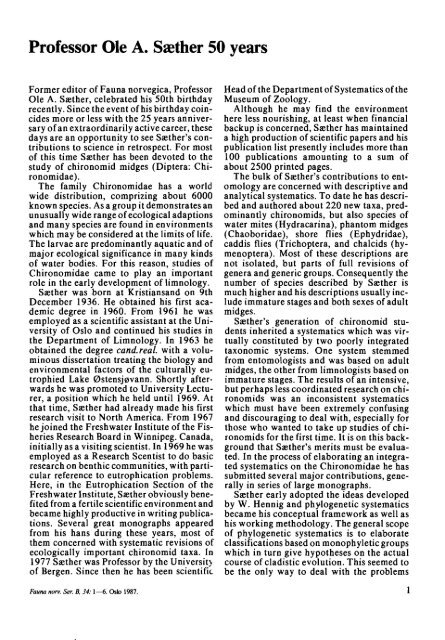Full-text - Norsk entomologisk forening
Full-text - Norsk entomologisk forening
Full-text - Norsk entomologisk forening
- No tags were found...
Create successful ePaper yourself
Turn your PDF publications into a flip-book with our unique Google optimized e-Paper software.
Professor Ole A. Srether 50 yearsFormer editor of Fauna norvegica, ProfessorOle A. Srether, celebrated his 50th birthdayrecently. Since the event of his birthday coincidesmore or less with the 25 years anniversaryofan extraordinarily active career, thesedays are an opportunity to see Srether's contributionsto science in retrospect. For mostof this time Srether has been devoted to thestudy of chironomid midges (Diptera: Chironomidae).The family Chironomidae has a worldwide distribution, comprizing about 6000known species. As a group it demonstrates anunusually wide range ofecological adaptionsand many species are found in environmentswhich may be considered at the limits oflife.The larvae are predominantly aquatic and ofmajor ecological significance in many kindsof water bodies. For this reason, studies ofChironomidae came to play an importantrole in the early development of limnology.Srether was born at Kristiansand on 9thDecember 1936. He obtained his first academicdegree in 1960. From 1961 he wasemployed as a scientific assistant at the Universityof Oslo and continued his studies inthe Department of Limnology. In 1963 heobtained the degree cand.real. with a voluminousdissertation treating the biology andenvironmental factors of the culturally eutrophiedLake 0stensj0vann. Shortly afterwardshe was promoted to University Lecturer,a position which he held until 1969. Atthat time, Srether had already made his firstresearch visit to North America. From 1967he joined the Freshwater Institute of the FisheriesResearch Board in Winnipeg. Canada,initially as a visiting scientist. In 1969 he wasemployed as a Research Scentist to do basicresearch on benthic communities, with particularreference to eutrophication problems.Here, in the Eutrophication Section of theFreshwater Institute, Srether obviously benefitedfrom a fertile scientific environment andbecame highly productive in writing publications.Several great monographs appearedfrom his hans during these years, most ofthem concerned with systematic revisions ofecologically important chironomid taxa. In1977 Srether was Professor by the Universityof Bergen. Since then he has been scientifi(,Head of the Department ofSystematics oftheMuseum of Zoology.Although he may find the environmenthere less nourishing, at least when financialbackup is concerned, Srether has maintaineda high production of scientific papers and hispublication list presently includes more than100 publications amounting to a sum ofabout 2500 printed pages.The bulk of Srether's contributions to entomologyare concerned with descriptive andanalytical systematics. To date he has describedand authored about 220 new taxa, predominantlychironomids, but also species ofwater mites (Hydracarina), phantom midges(Chaoboridae), shore flies (Ephydridae),caddis flies (Trichoptera, and chalcids (hymenoptera).Most of these descriptions arenot isolated, but parts of full revisions ofgenera and generic groups. Consequently thenumber of species described by Srether ismuch higher and his descriptions usually includeimmature stages and both sexes of adultmidges.Srether's generation of chironomid studentsinherited a systematics which was virtuallyconstituted by two poorly integratedtaxonomic systems. One system stemmedfrom entomologists and was based on adultmidges, the other from limnologists based onimmature stages. The results of an intensive,but perhaps less coordinated research on chironomidswas an inconsistent systematicswhich must have been extremely confusingand discouraging to deal with, especially forthose who wanted to take up studies of chironomidsfor the first time. It is on this backgroundthat Srether's merits must be evaluated.In the process of elaborating an integratedsystematics on the Chironomidae he hassubmitted several major contributions, generallyin series of large monographs.Srether early adopted the ideas developedby W. Hennig and phylogenetic systematicsbecame his conceptual framework as well ashis working methodology. The general scopeof phylogenetic systematics is to elaborateclassifications based on monophyletic groupswhich in turn give hypotheses on the actualcourse of cladistic evolution. This seemed tobe the only way to deal with the problemsFauna norv. Se,. B, 34: 1-6. Oslo 1987.

















